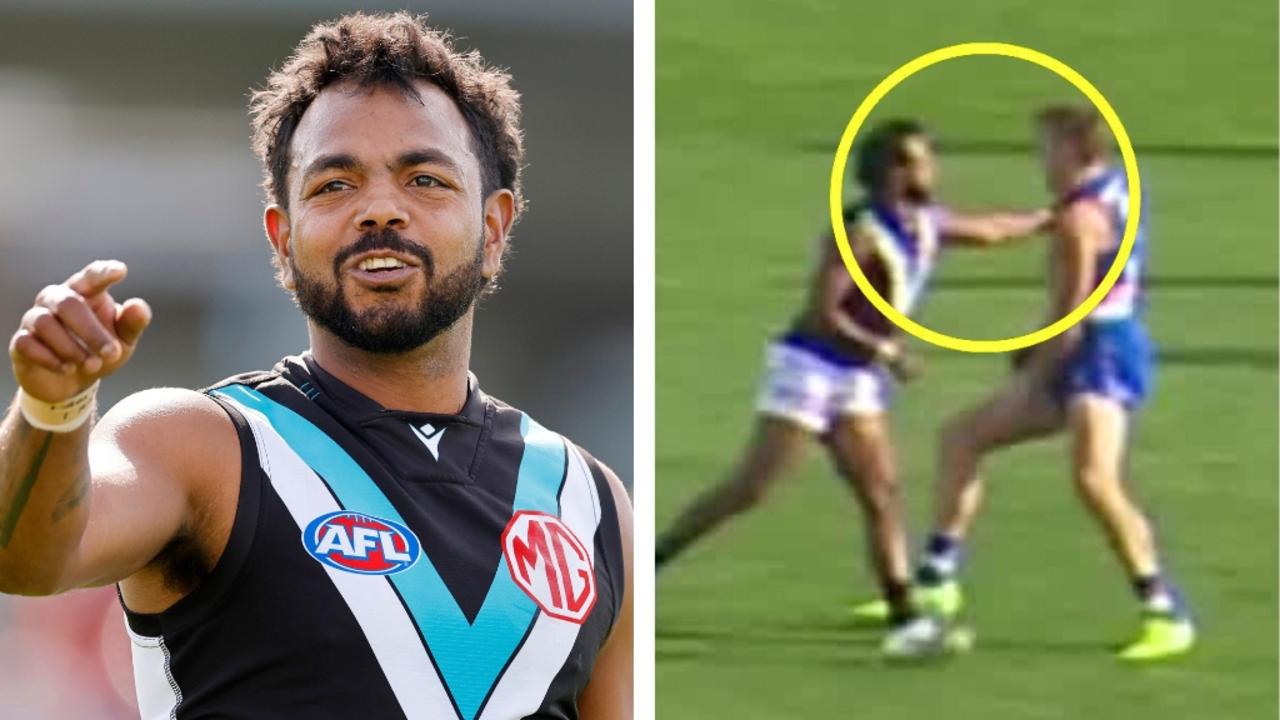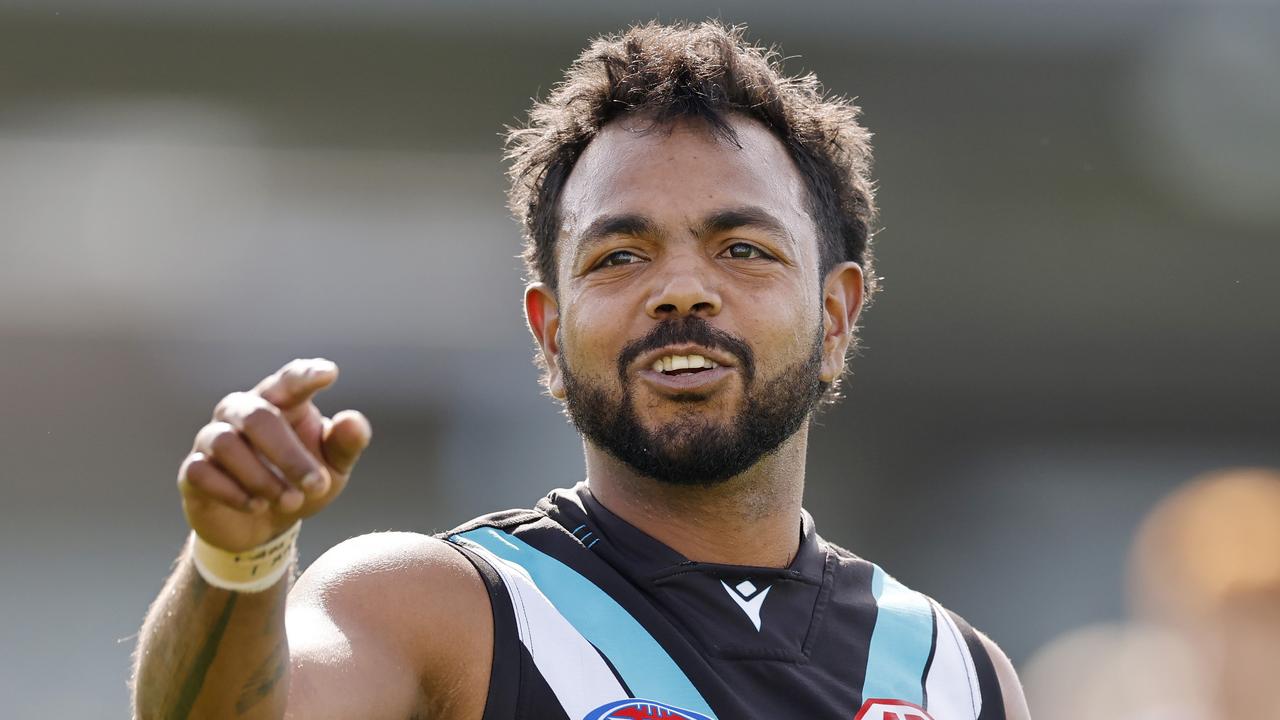Anzac Day AFL: Remembering four players from Melbourne’s 1940 premiership side who died at war
Four current Demons wear their numbers with pride, knowing the significance of their wartime legacy. Glenn McFarlane remembers those who came before them.
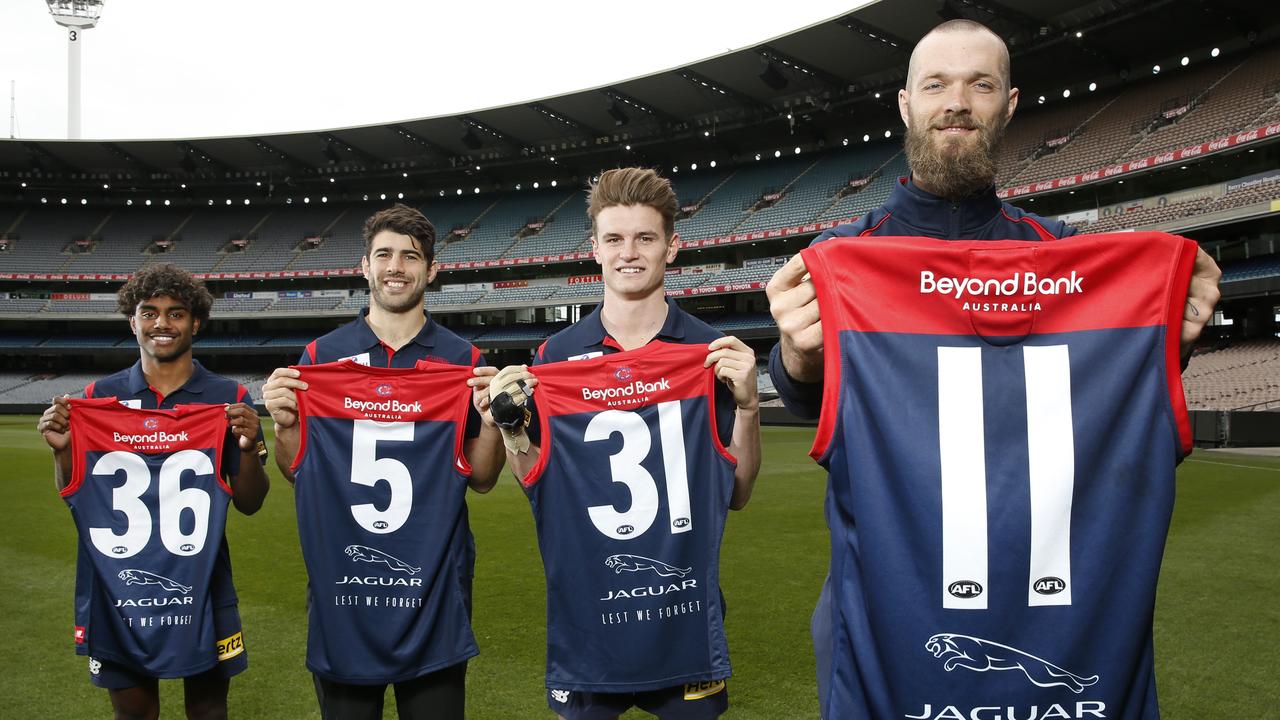
AFL
Don't miss out on the headlines from AFL. Followed categories will be added to My News.
One of the most poignant speeches legendary coach Frank ‘Checker’ Hughes ever delivered came before a nondescript home-and-away match at an unusual venue where the only things at stake were pride and honour.
It was August 11, 1945, two days after the US dropped a second atomic bomb on Japanese soil and four days before the official end of the most destructive war in history.
No one needed to remind Hughes — a World War I veteran — of the extraordinary toll exacted across the previous six years.
Thirteen players who had once worn Melbourne’s famous red and blue had died as a result of World War II, including four members of the 1940 premiership side — the second of a three-peat of flags.
Watch the 2021 Toyota AFL Premiership Season. Every match of every round Live on Kayo. New to Kayo? Try 14-Days Free Now >
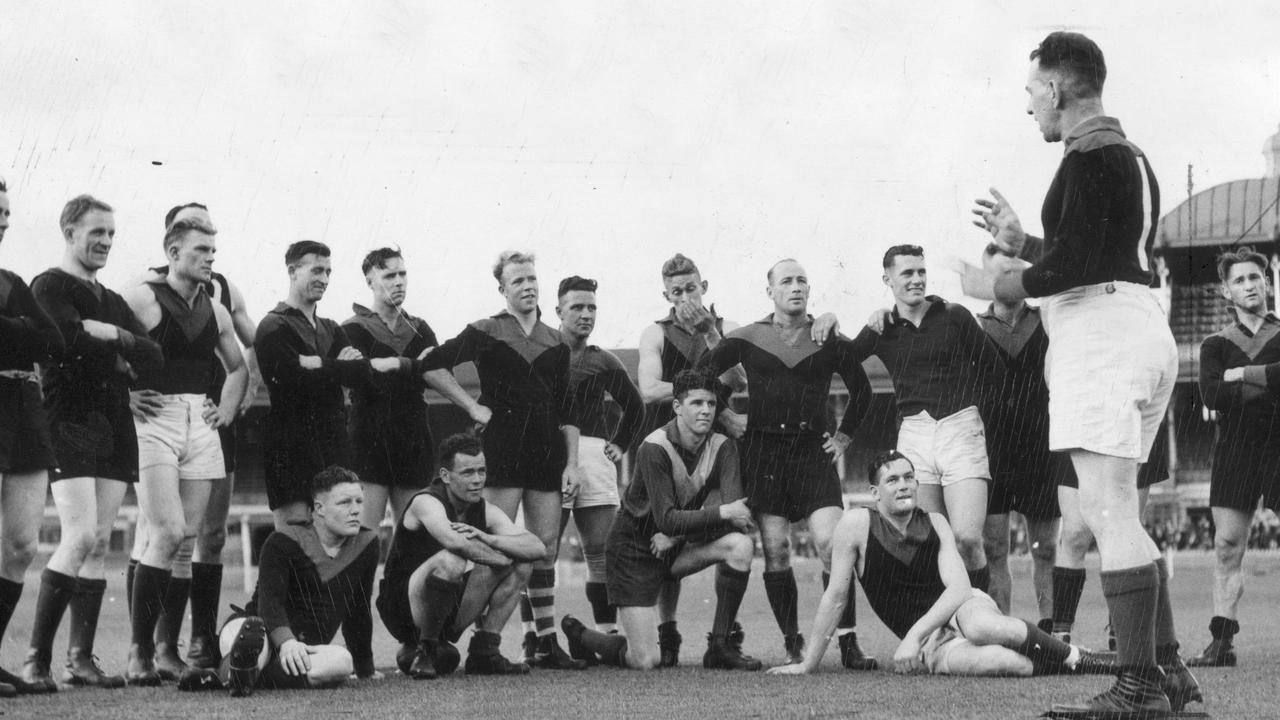
On this day, at Punt Road, a ground the Demons shared with Richmond for a time owing to the military use of the MCG, Hughes noted the fresh faces in his team who wore guernsey numbers of those who had been lost.
Melbourne was playing higher-ranked Footscray, and needed inspiration to cause an upset. Hughes chose his words carefully, then delivered them from the heart.
“This will probably be the last game of football you will play during the war period,” Hughes bellowed.
“During the war, many of you young players have been wearing the numbers of players who have made this club famous. Some of them have made the supreme sacrifice.
“Those players were champions because they would never admit defeat.
“You are playing a team above you on the premiership list. You have the ability to win. Now go out there and win!”
Hughes’ words inspired his team on to an emotional nine-point win.
He had vowed Melbourne would never forget the men who went to war and never returned.
As the book Fallen detailed: “The 1940 Melbourne side was rated as good as any team in an era and old Red-leg fans insist their club would have won far more than three consecutive flags had it not been for World War II.
“No less than four players — (Syd) Anderson, Ron Barassi Sr., Keith ‘Bluey’ Truscott, and Harold Ball … made the supreme sacrifice.”
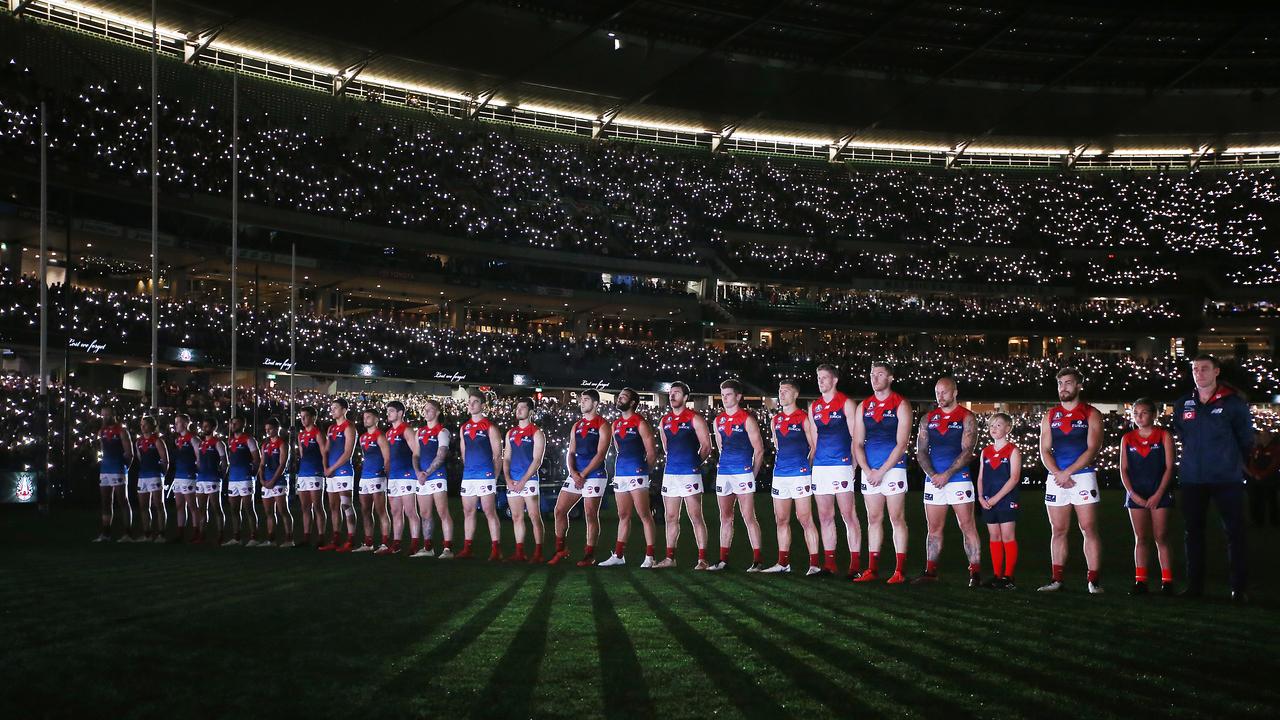
Almost 80 years on, the Melbourne Football Club has unquestionably lived up to Hughes’ pledge.
Those players have not been forgotten.
Truscott posthumously had the club’s best and fairest award named after him.
The names of Anderson and Barassi adorn the second and third best and fairest awards, while the club’s best young player is named after Ball.
The Demons are locked into an annual Anzac Eve clash with Richmond — the other club Hughes coached — with Saturday night’s game set to be one of the biggest matches of the year, given the on-field feats of both sides.
Fittingly, some of the players behind Melbourne’s 2021 resurgence wear the numbers of those fallen players.
Skipper Max Gawn wears No. 11, the jumper Ball wore in two flags.
It was fitting that Petracca won last year’s best and fairest eight decades after Truscott wore the No.5.
Exciting forward Kysaiah Pickett wears the No. 36 jumper that Anderson wore in his career.
The No. 31 jumper holds its own special place in the hearts of the Melbourne Football Club. Ron Barassi Sr. wore it before he went to war, and his son Ron Jr. famously wore it on his way to becoming a football legend – even though he always maintained it was his dad’s number, not his.
Now it is worn with pride by Bayley Fritsch.
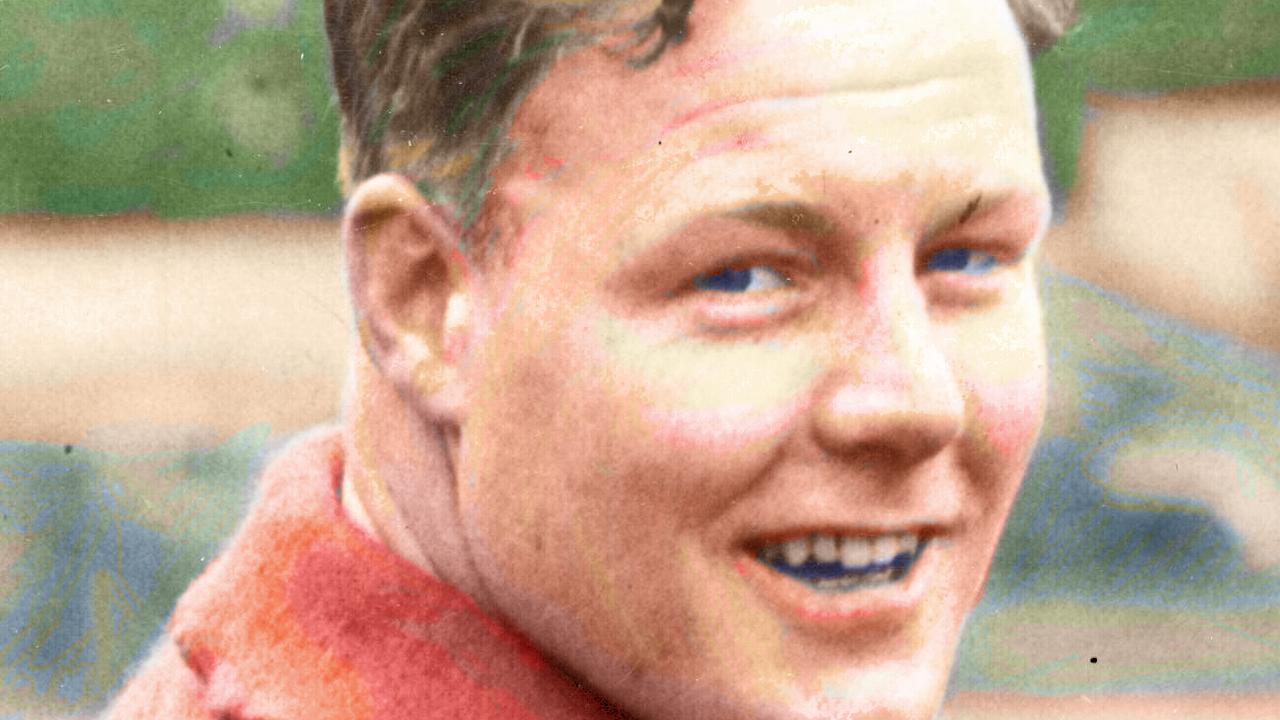
Gawn said the current Demons felt honoured to represent the players of the past.
“The Anzac Eve match is a match that is much more than a game of footy,” Gawn told the Herald Sun. “Tragically, 30 Melbourne players died while on active service during World War I and World War II, and to be able to acknowledge this on Saturday night will be incredibly special.
“Harold Ball, who wore number 11, has an extraordinary story. He was with the club for only two seasons and achieved the ultimate success, playing in premierships in 1939 and 1940.”
Petracca said: “It is an absolute honour and privilege to wear the number five guernsey, particularly given that Keith ‘Bluey’ Truscott, who our best and fairest award is named after, wore it during his five seasons with the club.”
“It means so much that we will be able to acknowledge those who have not only died while serving for our country, but also to recognise those who are currently serving.”
THE 1940 PREMIERSHIP DEMONS WHO DIED AT WAR
HAROLD BALL
Melbourne, 1939-40
No. 11
33 games, 33 goals
Two premierships (1939, ‘40)
Killed in action: February 9, 1942, aged 21
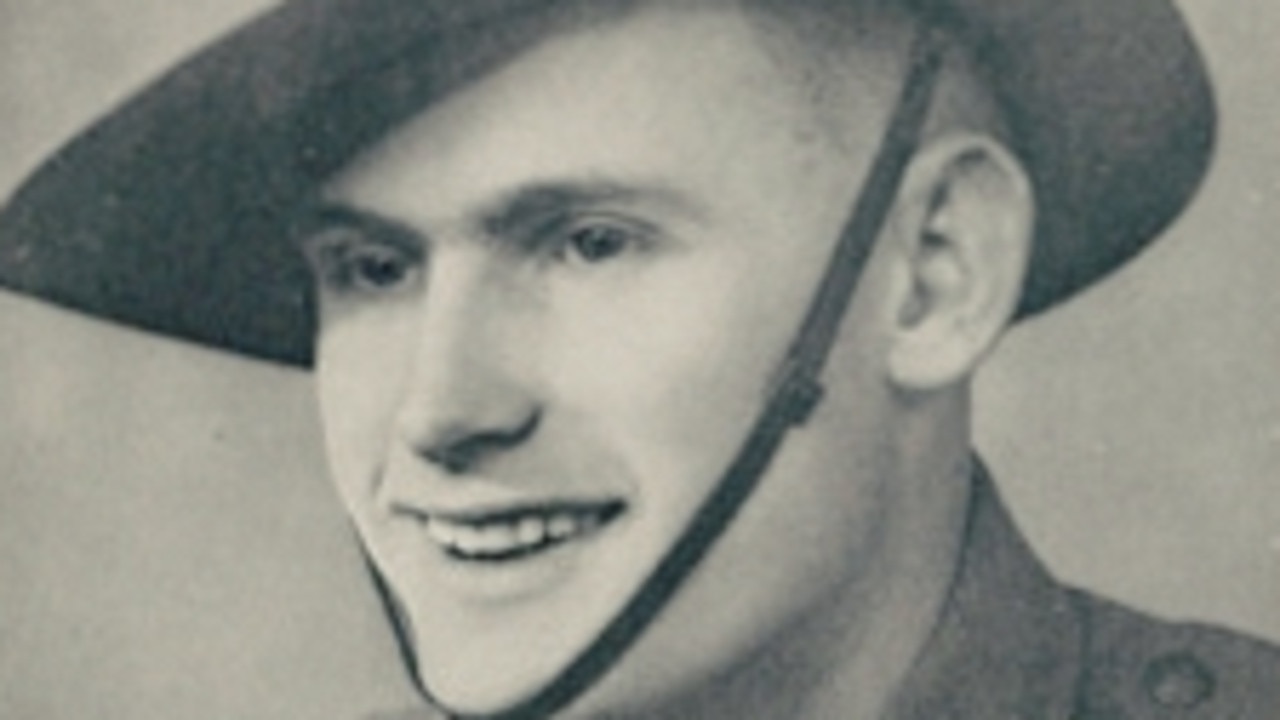
Melbourne’s secretary Percy Page was chasing a player from Merbein in the late 1930s when a local coach declared: “There’s a long skinny kid in the side I’m coaching who would make a good footballer.”
That kid turned out to be Harold Ball.
Ball ended up being instrumental in Melbourne’s 1939 and 1940 premiership sides.
The Sporting Globe’s Hec de Lacy said: “Remember Hal Ball, the best young ruck prospect we had seen in years? Ball did a dozen jobs (in 1940). Finally, they played him at full-back.”
Following the 1940 Grand Final de Lacy remarked to a colleague: “After the war this fellow will be a champion” to which the other journalist remarked: “He’s a champion now.”
Ball joined the 2/9th Field Ambulance and left Australia on February 4, 1941, just months after the Grand Final victory, bound for Singapore.
He wrote home to his parents, saying: “Don’t worry, there’s not a bullet made that can travel as fast as I can”.
Ball was only 21 when the Japanese Imperial Army mercilessly swept through Singapore.
On February 9, 1942, against an overwhelming tide of opposition, he was busy assisting a young doctor “collecting and transporting the wounded”.
In the chaos he and his fellow ambulance workers were reported missing in action.
‘Checker’ Hughes would say a decade later: “Hal never got back … the (Japanese) were pressing them mercilessly … (but) to leave a wounded man was to condemn him.”
Private Ball’s body was found three months later by a party of Australian prisoners of war, identified by the identity disc attached.
There had been “indisputable evidence” he and his mates had been executed.
SYD ANDERSON
Melbourne, 1939-41
No. 36
52 games, 12 goals
Three premierships (1939, ‘40, ‘41)
Killed in action: May 20, 1944, aged 26
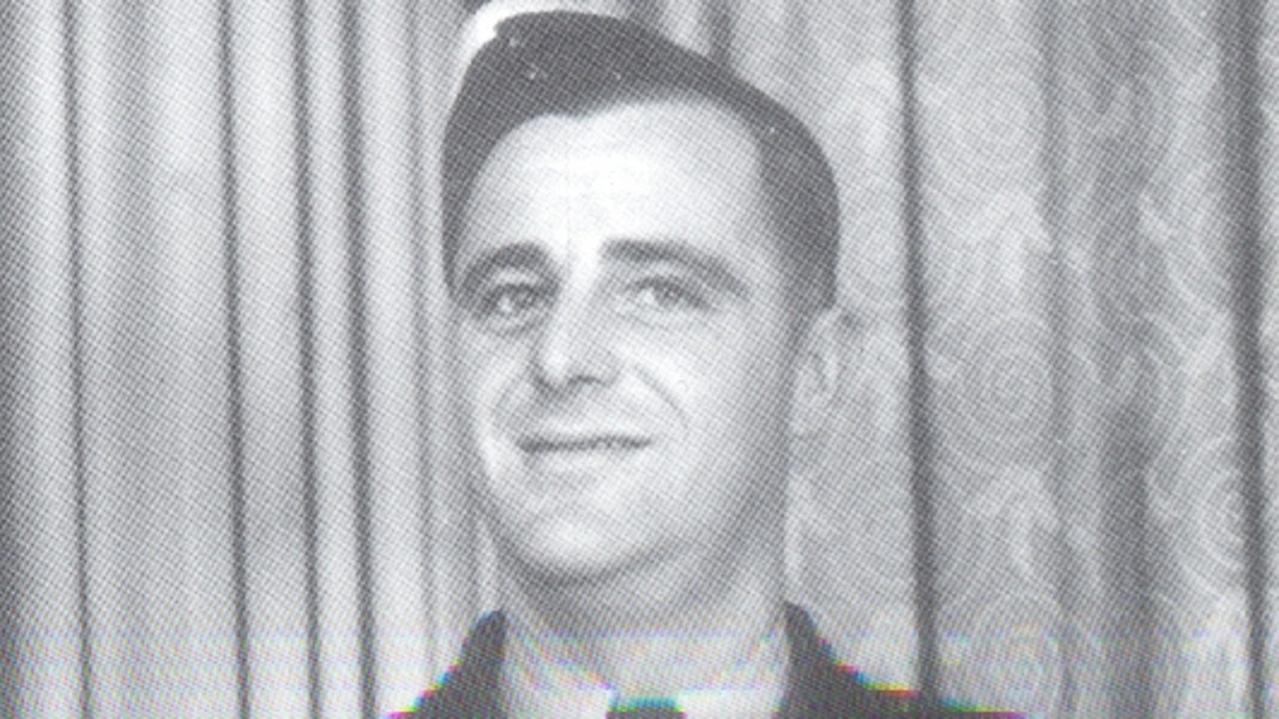
The Sporting Globe described Syd Anderson as “slim, graceful; big for a wingman, but a classic type: fast, resolute, brilliant, a fine mark, a long-legged hare: many a fine game he gave the Demons.”
Anderson was like a comet that flashed across the sky and was gone. He played only 52 games across three seasons, incredibly for three premierships.
One of his greatest performances came in the 1939 Grand Final.
Anderson joined the RAAF and went off to war.
On May 20, 1944, he was a navigator on a Beaufort plane off Wewak in New Guinea when it was shot down by the Japanese.
The official war history recorded: “(The plane) was hit by anti-aircraft fire … one of the engines caught fire and the pilot came down in the sea about twenty yards offshore.”
“The crew, who were injured, took to the dinghy and paddled seaward, but Japanese soldiers opened fire from the shore with machine guns as soon as the dinghy left the shelter of the aircraft.”
“Anderson (was) killed by machine gun fire which sank the dinghy.”
Three telegrams were sent to his wife Lorna.
The first said her husband was “missing in action”. The second: “missing, presumed dead.”
The final one was a crushing blow – Lorna’s sweetheart and the father of their daughter Tricia had been “killed in action”.
Anderson has no known grave, but is commemorated at the Lae Memorial in New Guinea.
RON BARASSI SR.
Melbourne, 1936-40
No. 31
58 games, 84 goals
One premiership, 1940
Died of wounds: July 31, 1941, aged 27
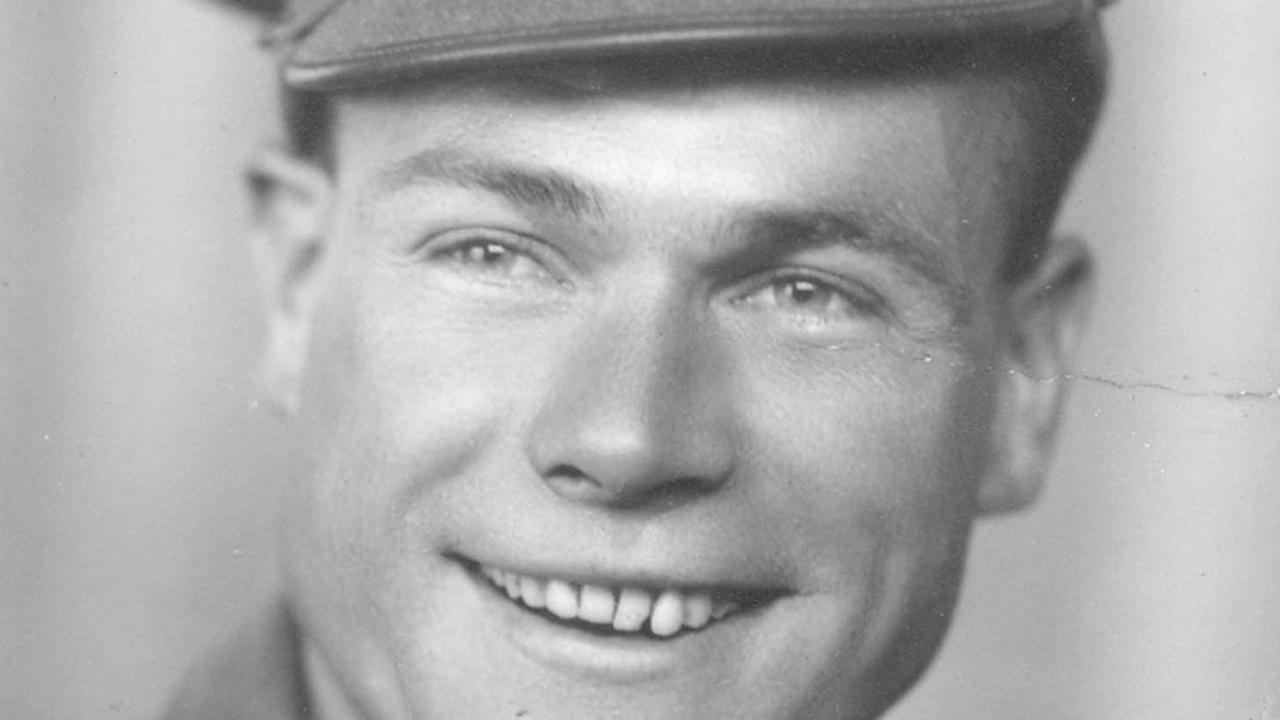
One of football’s biggest names, Ron Barassi Jr. has no real recollections of his own hero – his father of the same name, who was killed at Tobruk, when he was only five.
“My mother and I were staying with my uncle and his family in Footscray,” Barassi Jr. recalled.
“I remember the telegram (detailing his father’s death) arriving at the house. It was just a scene of utter grief. War is a terrible thing.”
Barassi’s father, Ron Sr., had played the most important football match of his life when coming on as the 19th man in Melbourne’s 1940 victorious Grand Final clash with Richmond.
Just 307 days later, he was dead, after a German air raid at Tobruk.
“He was a truck driver in a division that drove the supplies,” Barassi Jr., said. “The soldier scheduled to go out that night was ill. So, from what I can understand, my father volunteered to take his place. The Nazis either bombed the place or a mile that was meant for the harbour exploded against a wall. My father and his co-driver were hiding behind this wall. He didn’t die instantly. He lasted about 10 hours.”
Soon after Barassi’s death, Melbourne played Collingwood at the MCG. Players from both sides lined up in the middle to pay tribute to a fine footballer and an even better Australian.
The Sporting Globe recorded: “In dying at Tobruk, (Barassi) perpetuated his memory in a way that years of brilliant service with Melbourne could not have done.”
In the rooms before the 1941 Grand Final – just months after his death – the Melbourne Football Club displayed “a framed document which must be unique in the history of any sporting club in Australia.”
It was a pledge to look after the “material welfare” of Barassi’s widow Elza and his son Ron Jr.
That pledge was honoured.
By 1953, a dozen years after his father’s death, Ron Barassi Jr. became the second player selected under the father-son rule.
As he explained: “The respect for football’s contribution to the greater fight in the war helped the VFL buy into the father-son rule. Melbourne first came up with the proposal … if they hadn’t, I would have been residentially bound to play for either Collingwood or Carlton.”
Imagine how the course of football history might have changed if that had happened.
KEITH ‘BLUEY’ TRUSCOTT
Melbourne, 1937-42
No. 5
50 games, 31 goals
Two premierships, 1939, 1940
Killed in an accident: March 28, 1943, aged 26
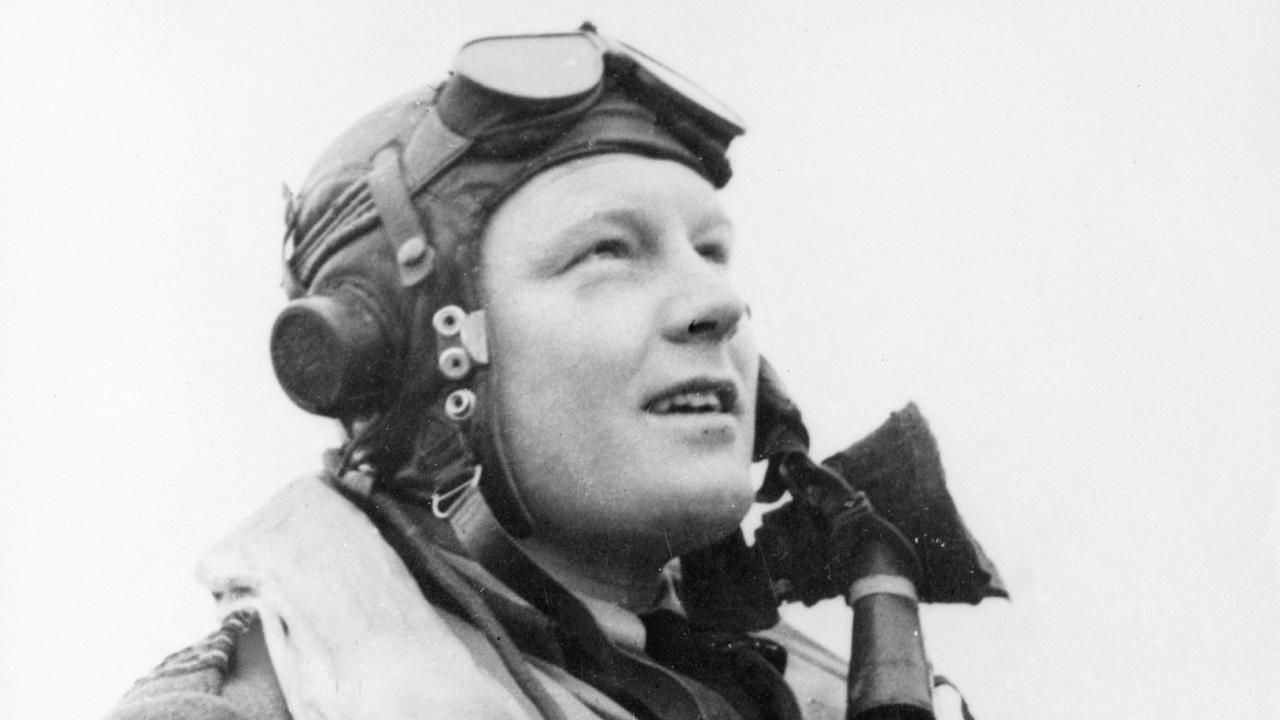
Larrikin and renowned fighter pilot Keith ‘Bluey’ Truscott returned to Australia early in 1942 following an extraordinary period over the skies of England and Europe.
Having been a solid (in physique and performance) player in Melbourne’s 1939 and ‘40 flags, where he was once called “the red-headed bullet”, Truscott achieved legendary status from his aerial conquests in the early 1940s, winning the Distinguished Flying Cross.
Such was his acclaim that the “redheads of England” raised 5000 pounds to fund a new Spitfire for the air ace after he had ditched his plane in yet another hair-raising experience.
His return to Melbourne – and the southern theatre of war – made for one of footy’s most remarkable and short-lived comebacks.
While on leave, Truscott turned out for the Demons against Richmond in Round 2, 1942.
The normally fearsome Jack Dyer organised “three cheers” for Truscott from the crowd, girls threw rose petals at him, he was made skipper for the day and even promoted to the No. 1 jumper.
He even kicked a goal after what some thought was a “deliberate mistake” from an opponent.
Melbourne lost the game, but ‘Bluey’ was feted.
When his old schoolteacher, former Australian Test captain Bill Woodfull, asked him if he had enjoyed the game, Truscott said with a smile: “No, it’s too dangerous.”
It was his 50th – and final – VFL game.
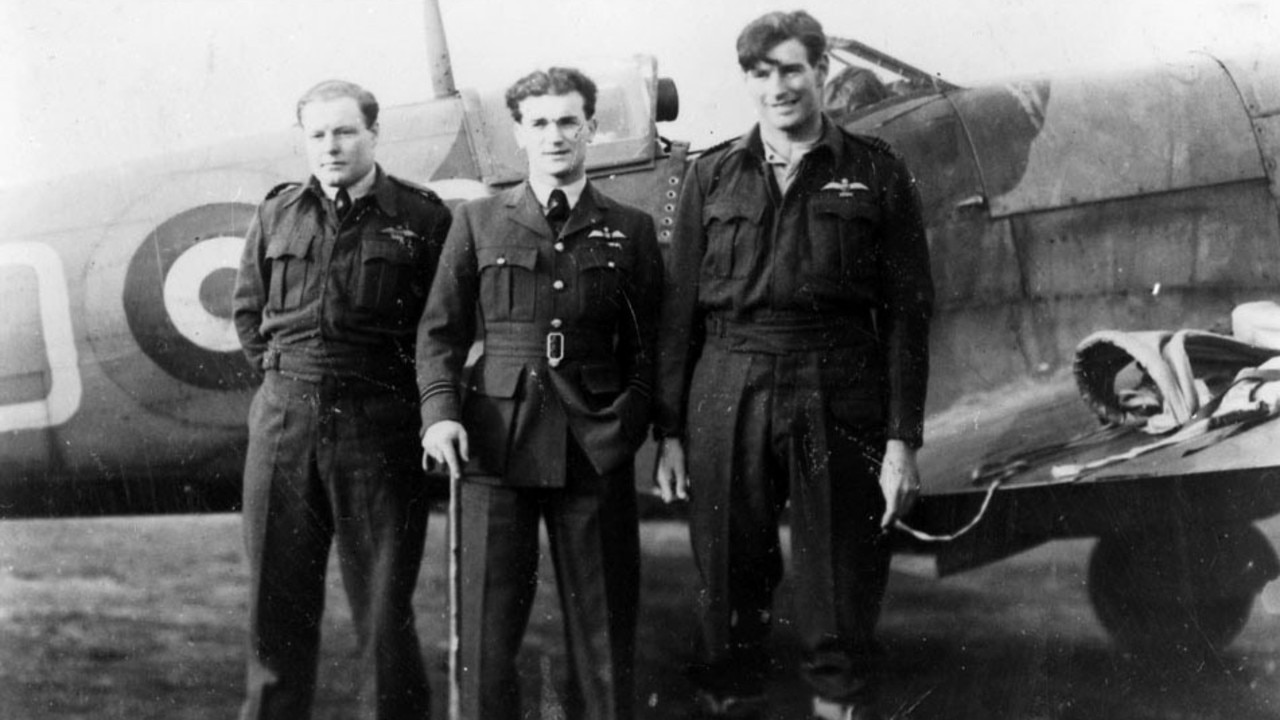
Just under a year later, on March 28, 1943, the 26-year-old was killed when he crashed his plane into the sea off the coast of Western Australia during a joint Australia-US training exercise.
The Sporting Globe mourned: “No other single individual item of news concerning any single individual has affected the members of the Australian services throughout the world and Victorian sportsmen so much as the report that ‘Bluey’ Truscott is missing, believed killed.”
One of his mates, Harry Ince, said: “I thought of him as I had last seen him and the promise that he made to keep two bottles (of beer) on ice for me.”
More Coverage
Originally published as Anzac Day AFL: Remembering four players from Melbourne’s 1940 premiership side who died at war







